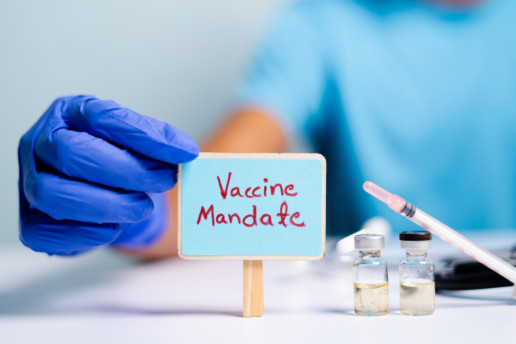SCOTUS BLOCKS FEDERAL VACCINE MANDATE
After a long road of legal challenges and in a much-anticipated ruling, moments ago, the United States Supreme Court blocked the COVID-19 Vaccine Mandate.
In the final blow to the sweeping requirements set to impact over 80 million workers across the nation and their employers, SCOTUS found that the Emergency Temporary Standard (ETS) issued by the Occupational Safety and Health Administration (OSHA) exceeded the power given to them by Congress. This means that the requirements for employers with 100+ employees to implement policies that required employees to receive the COVID vaccine or wear masks and test weekly is dead in the water.
"Although Congress has indisputably given OSHA the power to regulate occupational dangers, it has not given that agency the power to regulate public health more broadly," the court's majority said. "Requiring the vaccination of 84 million Americans, selected simply because they work for employers with more than 100 employees, certainly falls in the latter category."
Further, the court ruled that OSHA lacked the authority to impose such a mandate because the law that created OSHA "empowers the Secretary to set workplace safety standards, not broad public health measures."
"Although COVID-19 is a risk that occurs in many workplaces, it is not an occupational hazard in most," the Court ruled. "COVID–19 can and does spread at home, in schools, during sporting events, and everywhere else that people gather. That kind of universal risk is no different from the day-to-day dangers that all face from crime, air pollution, or any number of communicable diseases."
Alongside the ruling on the OSHA ETS case, the U.S. Supreme Court will allow a portion of the CMS mandate impacting an estimated 10 million health care workers to be enforced. The allowable portion of the CMS mandate requires vaccinations for health care workers who treat Medicare and Medicaid patients at facilities that receive federal funding.
In this ruling, the Court noted that "healthcare facilities that wish to participate in Medicare and Medicaid have always been obligated to satisfy a host of conditions that address the safe and effective provision of healthcare, not simply sound accounting."
Please check back with us as we work to source additional information and resources, particularly next steps for employers who may have already implemented requirements for their workforce, and taking the necessary steps to ensure you continue to meet your state requirements in your workplace.
SCOTUS Decision On Vaccine Mandate: How it Works
At 12 a.m. on January 13th, SCOTUS published a post that they would be live blogging as the court released opinions in one or more argued cases from the current term. Many experts quickly jumped to the conclusion that there was a high likelihood that the ruling on both the OSHA and CMS cases may be the highlight only to be very quickly disappointed. This early speculation led to a frustrating letdown today as SCOTUS did not release an opinion on the vaccine mandate.
If like many, you are watching the play-by-play in the news and just want a direct line to the ruling when it comes, here is some information, resources, and quick tips that may help you!
Decision Day
With SCOTUS decisions, it is not as simple as saying we will be able to tune in for X decision on X date. The U.S. Supreme Court does not set dates for releasing opinions but rather posts digitally to a public calendar when opinions will be released without noting what opinions will be included in that release. For example, SCOTUS updated its calendar yesterday for the remainder of January including the note that one new opinion would be released today. Of course, speculation began to fly as to whether the opinion released would be that on the OSHA/ETS cases.
SCOTUS Opinion Releases: How It Works
SCOTUS opinions are often accompanied by a public reading of at least part of the final decision read aloud by the Justice that authored the majority opinion. Opinions are often available for public consumption either via the live SCOTUS blog and/or a live stream (audio and/or video) on the SCOTUS website homepage. Opinion days are posted to the SCOTUS calendar and released at 10am EST on the posted calendar date. If you are watching the releases live there are a couple of good things to know:
- How do I know they have finished releasing opinions for a given day? Opinions are released with an associated number. These are the numbers that correspond to opinions in the left-most column on the court's opinion page. When the court releases multiple opinions on a single day, the R numbers don't appear until the court has released its final opinion of the day. So when an R number DOES appear (as it did for Babcock today), we can be sure the court is done for the day.
- Are there any exceptions? White flags of impatience were being raised across the SCOTUS blog this morning with many expecting and not getting the decision for the OSHA/CMS cases. Given that there are no additional opinion issuance dates on the SCOTUS calendar for the month of January, questions and frustrations began to fly. However, just because you don't see it on the calendar now, doesn't mean a decision is not imminent.
- Opinion issuance days tend to only be scheduled a few days out. And with the opinion announcements purely electronic, we could theoretically get them even when the justices are theoretically on their winter recess -- a change from non-pandemic times.
- Emergency applications are different: Rulings on the vaccine cases could technically come at any time (because they are on the emergency docket, so the court might not announce in advance when they are coming).
Resources to Stay Up-To-Date with SCOTUS
What Employers Should Do While Mandate Is In Limbo?
Make no mistake that both the OSHA ETS and the CMS Healthcare Mandate already have compliance obligations in effect, and you can’t wait until the Court decides in order to act.
While some employers are taking a more conservative approach opting to 'slow roll' plans, policies and issuance of guidance for employees, other employers are moving forward with full compliance anticipating the ETS surviving the Supreme Court. No matter which camp you are in, one of the most vital things needed is consistent and clear communications to your employees on what they can expect in the coming days and where the company stands in regard to implementation and requirements for Vax-or-Test policies.
Currently, OSHA is looking for good faith efforts that employers are beginning to take steps towards compliance with full implementation of the requirements beginning February 1, 2022. To better understand the implications of OSHA's timeline and the definition of 'good faith', please take a look at our more detailed post better outlining what employers need to know.
Vaccine Mandate Status: Mid-Week Update
Here we are mid-week, and employers across the nation impatiently await word from the U.S. Supreme Court as to whether they will allow the OSHA ETS requiring employers with 100 or more employees to implement vaccinate-or-test policies in the workplace.
Here's What We Know
The Supreme Court's decision is pending. Since hearing the oral arguments on Friday, January 7th, there has been plenty of speculation regarding where the ruling may land, or if the court will issue a brief administrative stay until a decision can be made. In the meantime, the first compliance deadline of the ETS is here, so what does that mean for employers awaiting this decision?
What Employers Need to Know
OSHA's initial deadline of January 10th is based upon good-faith efforts being made by employers. So, what is considered 'good-faith efforts'?
- Employers should show that they are beginning to make efforts to comply with the mandate.
- Company leadership should be communicating a clear approach to how they plan to comply with this new policy.
- OSHA-covered employers must begin moving forward with a Vax-or-Test policy by
- Determining the vaccination status of all its employees by obtaining acceptable proof of vaccination,
- Maintain a roster of employee vaccination status,
- Unvaccinated employees should be wearing face coverings,
- Instate a policy for paid time off for vaccination and vaccination side effects,
- Provide guidance on how employees should provide (prompt) notice of a positive COVID-19 test or diagnosis,
- Ensure you are in compliance with not only the OSHA ETS, but also any state laws or mandates regarding testing, masking, vaccination, and PTO.
U.S. Supreme Court Hears Oral Arguments on OSHA ETS
OSHA ETS: Where are we now and what do we know
The United States Supreme Court heard oral arguments today on the legality of the ETS issued by the Occupational and Safety Administration in early November. Since the ETS release, legal challenges have been making their way through the legal system taking employers nationwide on a bit of a see-saw ride on whether the ETS will or will not be instituted come Monday.
Previous to the oral arguments today, on December 17th, a three-judge panel from the 6th Circuit Court of the United States lifted the latest stay and revived the ETS with immediate effect. Within hours of the ruling, an appeal was filed to the US Supreme Court by its challengers and OSHA made announcements on a timeline for enforcement.
Latest ‘Need to Know’ for Employers
Pending any overarching changes that may come from a Supreme Court ruling after oral arguments today, the ETS will take immediate effect on Monday, January 10th. OSHA has announced that it will not issue citations for noncompliance with any requirements of the ETS before January 10th, nor will it issue citations for noncompliance with the standard’s testing requirements before February 9th so long as an employer is exercising reasonable good faith efforts to come into compliance with the standard. Given that these dates are basically upon us, what next steps should an employer be focused on now?
- Determine if you are indeed covered by the ETS. To do so you need to answer the following:
- Is your workplace normally covered by OSHA?
- Do you have more than 100 employees nationwide?
- Are you exempt because you are covered by another ETS or mandate (i.e. Healthcare COVID-19 ETS or Federal Contractor mandate)?
- Gather vaccine status on your workforce.
- Develop the required vaccination roster for employees. Note whether the employee is fully vaccinated (as defined by the ETS).
- Determine if you will mandate vaccines or conduct testing.
- .Develop your vaccine-or-test policy.
- Create the required mandatory vaccine and/or testing/masking policies required under the ETS.
- Be prepared to implement said policy should the OSHA ETS move forward to enforcement or if the Supreme Court ruling does not change the current ETS status.
- Conduct compliance training & educate the workforce.
- Ready communications to inform and educate your workforce about your new policies, including posting necessary notices.
- Offer training for your managers to aid them in proper communication and enforcement of the said policy.
- Prepare a process/procedure for unvaccinated employee testing.
- Keep a roster of unvaccinated employees, as well as documentation of weekly test and test result.
- Provide a clear policy/procedure for testing and submitting test results.
- Keep negative/positive test results documented per employee as employees testing positive within the immediately preceding 90 days do not have to comply with a testing requirement.
- Provide clear policies for employees (vaccinated or unvaccinated) who may test positive for COVID-19.
- Handling exemptions:
- Federal law requires that you still need to consider and possibly accommodate valid medical and religious accommodation requests to a vaccination requirement.
- Ensure your policies provide provisions explaining how employees can request exemptions, including providing access to necessary paperwork, timelines for submission, and any additional policies or procedures that may impact exempt employees (such as remote work requirements, etc).
What’s Next?
Again, we wait to see what the justice system concludes. While many assumptions and predictions are being made, we simply don’t know what we don’t know. The only facts currently are, as of today (January 7, 2022):
- The OSHA ETS is due to take effect on Monday, January 10, 2022
- The oral arguments to both the employer mandate and the CMS rule have concluded. The US Supreme Court is expected to either institute a stay to allow additional time to review the arguments and make a ruling or, and less likely, issue an immediate ruling on the legality of the OSHA ETS and its implementation. Should a stay be issued by the high court, it is widely expected to be announced sometime over the weekend before the ETS can take effect on Monday.
Stay Tuned next week for more details as we monitor this developing situation.
Senate Passes Bill to Overturn Biden Vaccine Mandate
Yesterday, in the latest blow to Biden's vaccine mandate for businesses, the United States Senate passed a bill that would overturn President Joe Biden's COVID-19 vaccine mandate for private businesses. The legislation will now go to the House of Representatives, where it potentially faces strong opposition. If it passes in the House, Biden has threatened to veto it. While this is significant in terms of the ongoing battle to prove the legality of the mandate itself, it doesn't change much for employers. So what does it all mean and what happens next?
Quick Catch Up:
-
All three orders of the vaccine mandate, (employers with over 100 employees, federal contractors and subcontractors, and health care workers), have been temporarily blocked from being enforced via separate court rulings. These rulings have effectively barred any implementation nationwide.
-
For now, there are no deadlines related to the original ETS or Executive Orders that employers are required to meet regarding COVID-19 vaccination policies or enforcement of vaccination or testing amongst employees.
The Vaccine Mandate Timeline:
- 9/9/21: Biden Administration announces new COVID-19 Action plan, the first portion of which involved:
- The signing of two new Executive Orders that would require vaccinations for all federal workers and contractors.
- Instructed the Department of Labor's (DOL) Occupational Safety and Health Administration (OSHA) to develop a rule requiring employers with 100 or more employees to ensure their workforce is fully vaccinated to require unvaccinated workers to produce weekly negative test results leveraging the use of an emergency temporary standard (ETS).
- Instructed the Centers for Medicare and Medicaid Services (CMS) to develop a rule requiring workers in health care settings that receive Medicare and Medicaid reimbursements to implement vaccination and testing protocols.
- 11/4/21: The U.S. Department of Labor's Occupational Safety and Health Administration (OSHA) issued an emergency temporary standard (ETS) requiring large employers (100+ employees) to develop, implement and enforce a COVID-19 vaccination policy or institute a policy to allow employees to choose between vaccination and weekly testing.
- 11/5/21: ETS took effect on 11/5/21.
- 12/5/21: Employers were to have vaccination policies in place.
- 1/4/22: Deadline for employers to be in compliance; employees to be fully vaccinated or begin regular testing.
- 11/5/21: The 5th U.S. Circuit Court of Appeals issued a stay on the ETS, citing challenges the plaintiffs brought against the ETS "show a great likelihood of success on the merits."
- 11/12/21: The 5th Circuit Court of Appeals extended the original order made on 11/5/21.
- 11/16/21: The 6th U.S. Circuit Court of Appeals was selected in a lottery held by the Judicial Panel on Multidistrict Litigation to hear 34 consolidated challenges to the ETS.
- The date for this hearing has not yet been scheduled. It has been noted that the court is not expected to rule on the stay until December 10th at the earliest.
- 11/30/21: U.S. District Court issued a nationwide preliminary injunction to halt the start of President Biden's national vaccine mandate for health care workers.
- 12/2/21: Centers for Medicare and Medicaid Services (CMS) issued a memo announcing it was suspending enforcement of the mandate due to U.S. District Court ruling while it appeals the court decisions.
- 12/7/21: U.S. District Court issued a nationwide stay barring the enforcement of Executive Order 14042 for federal government contractors and subcontractors until further notice.
What's Next?
Keep an eye out for updates, particularly from the 6th Circuit Court of Appeals which is the next decision expected before we wrap 2021. However, no matter the outcome at the 6th Circuit Court, this is very likely to eventually make its way to the Supreme Court. Stay tuned and stay well!





